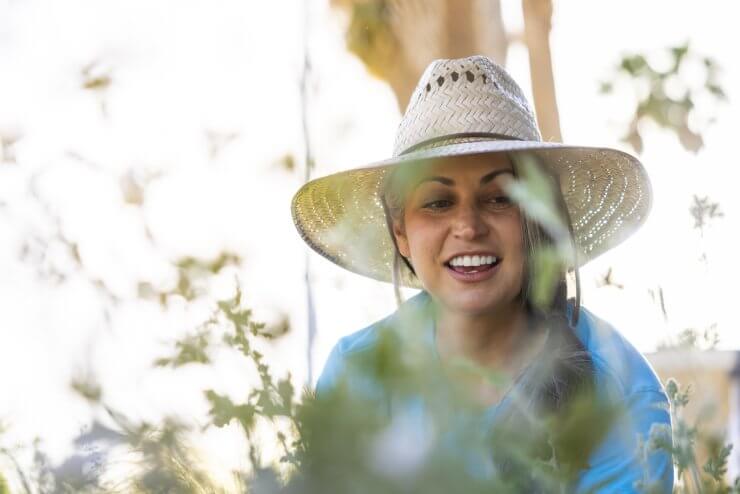
Learning how to protect your eyes in the garden is essential for anyone who spends time tending to plants, especially when working with species that can cause irritation or injury.
Signs of Plant-Related Eye Irritation
If you experience any of these symptoms while gardening, you may have had contact with a plant that causes irritation:
- Redness or bloodshot appearance
- Itching or burning sensation
- Excessive tearing
- Swelling of the eyelids
- Blurred vision
- Pain or discomfort
- Sensitivity to light
How to Protect Your Eyes in the Garden
The garden should be a source of joy and relaxation, not a place that causes problems. Here’s how to keep your eyes safe.
1. Identify Common Garden Irritants
Some of the most beautiful plants can be the most harmful. Sap and onion fumes can cause eye irritation, rashes or respiratory discomfort. Understanding which plants pose a risk allows you to handle them with care.
Many beloved garden plants contain sap or oils that cause significant eye irritation or damage:
- Poison ivy, oak and sumac: The urushiol oil in these plants can cause severe reactions if it comes in contact with your skin or eyes. Even airborne particles from burning them can cause eye damage.
- Euphorbia family: These popular ornamentals contain a milky sap that can cause severe eye irritation and even temporary blindness if it contacts your eyes. Species include poinsettias, crown of thorns and many succulents.
- Allium family: Onions, garlic, leeks and chives release compounds that can irritate your eyes when cut or damaged. The sulfenic acid they release converts to syn-propanethial-S-oxide, which stimulates your eyes’ tear ducts, causing irritation.
- Philodendron and dieffenbachia: Also known as dumb cane, this common houseplant contains calcium oxalate crystals that can cause intense pain, burning and inflammation if it contacts your eyes.
- Foxglove: All parts of this plant contain cardiac glycosides that can be toxic and irritating to the eyes.
Research any new plant before adding it to your garden, and always wash your hands thoroughly after handling any unfamiliar foliage.
2. Essential Safety Gear
With the right equipment, you can enjoy all the benefits of gardening while keeping your precious vision safe from harm. Consider:
Protective Eyewear
Safety glasses or goggles are your most important tool for eye protection while gardening. They create a physical barrier against sap, pollen, dust and debris that could otherwise damage your eyes.
Protective eyewear is getting a contemporary upgrade with designs that combine functionality and style. Safety glasses now feature streamlined profiles and fashionable frames, making them appropriate for both garden work and everyday wear. Modern options include innovative features like removable side shields, interchangeable tinted lenses for different light conditions and photochromic technology that automatically adjusts to changing sunlight levels throughout your gardening day.
Wide-Brimmed Hats
A wide-brimmed hat provides additional protection by blocking overhead debris and reducing glare. Look for hats with at least a 3-inch brim all around to maximize coverage.
Face Shields
When working with particularly hazardous plants like euphorbias, a full face shield offers the most comprehensive protection. These clear plastic shields protect your entire face while providing excellent visibility.
3. Handle Plants Safely
Research the plants in your garden to identify which ones pose eye hazards. Mark potentially dangerous ones with special tags or place them in designated areas where you’ll remember to take extra precautions.
When working with known irritants:
- Approach plants from below rather than above when possible.
- Use long-handled tools to maintain distance.
- Cut stems at a downward angle to direct sap away from you and have paper towels ready to quickly wipe them.
- Dispose of cuttings promptly in a designated container.
- Clean tools immediately after use.
4. Beware of Wind-Carried Irritants
Wind can stir up pollen, dust and fine plant particles that lead to itchy, irritated eyes. If you have allergies or sensitivity to airborne irritants, consider wearing a hat with a brim and using lubricating eye drops before and after your gardening session. Sunglasses or wraparound safety glasses can provide an additional barrier against windblown debris.
5. Properly Store and Use Garden Chemicals
Fertilizers, herbicides and pesticides can pose serious risks to eye health if mishandled. Always read the labels carefully and follow the manufacturer’s guidelines for safe use. Store chemicals in a secure location, and wear protective gear — including gloves and eye protection — when applying any treatment to your plants.
6. Keep Your Hands Away from Your Face
It’s easy to rub your eyes while working in the garden, but doing so with plant residue or soil on your hands can introduce irritants. Keep a clean cloth or disposable wipes nearby to dab sweat away instead. Washing your hands frequently, especially before touching your face, is a simple yet effective way to prevent eye irritation.
Know What to Do in Case of Exposure
Despite precautions, accidents happen. If a toxic plant or chemical gets into your eyes, immediately rinse them with clean, lukewarm water for at least 15 minutes. Use a gentle stream from a cup, clean water bottle or eye wash station if available. If you wear contacts, remove them before flushing if possible. Don’t rub your eyes, as this can spread the irritant and potentially scratch the cornea.
Keeping a small first-aid kit with saline solution, gloves and eye drops in your garden shed ensures you’re prepared for minor emergencies. If pain, redness or vision changes persist after flushing, contact your doctor or go to an emergency room. Bring identification of the plant if possible.
Create an Eye-Safe Garden Environment
From common vegetables like onions to ornamental plants like euphorbia, your garden contains numerous potential irritants that require careful handling. By taking proper precautions, you can enjoy your gardening sessions while keeping your vision safe from harm.
Discover 7 top tips for growing, harvesting, and enjoying tomatoes from your home garden—when you access the FREE guide The Best Way to Grow Tomatoes, right now!




